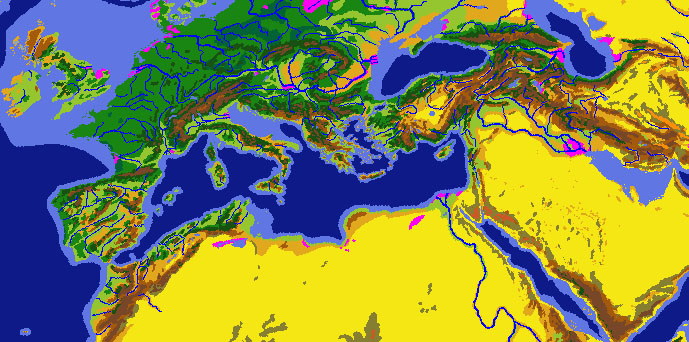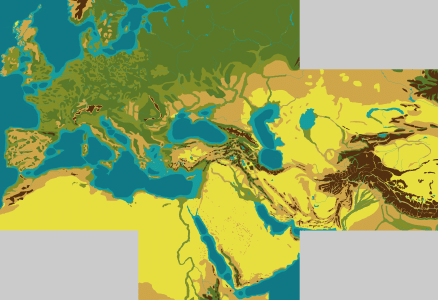You shouldn't discount civilizations just cos you don't know much about them. The Arabs of the ancient world were quite different than the Arabs of Mohammed's day. The century just before Mohammed saw the conquest and near total destruction of this civilization (after a long decline), the great cities abandoned.
But prior to that destruction, Southern Arabia was the wealthiest part of the world, according to Herodotus. The largest city, Marib, had a peak of about 30,000 people, which made it one of the biggest cities of the time (the Alexander era, the one I know most about). They even had buildings up to 8 stories high! There were numerous cities there, and vast irrigation networks, catching water from the very high (and forested!) mountains. Queen Bliqis, the Queen of Sheba, would make a great leader.
You probably think more of the Arabs of the north, Mecca and Medina and all that. Even they did much better than in Mohammed's day, profiting from the trade passing through. A second Arabian power center developed around the city of Petra in the north (also to later crash with the decline of the trade routes).
Here's some stuff I grabbed off the web. I'll do the same for Lydians later (who by the way were nowhere near the Persians, you must be thinking of something else).
Sheba, region, Arabian Peninsula
biblical name of a region, also known as Saba, of S Arabia, including present-day Yemen and the Hadhramaut. Its inhabitants were called Sabeans. According to some passages in Genesis and First Chronicles, Sheba (the Hebrew spelling of Saba), a grandson of Noahs grandson Joktan, was the ancestor of the Sabeans. According to other passages in those books, however, Sheba was a descendant of Abraham. The Semitic colonization of Ethiopia was established (10th cent. B.C.) from Sheba. In that century the biblical queen of Sheba (called in Muslim tradition Bilqis) made her famous visit to Solomon. Situated along the trade route from India to Africa, Sheba was known as a region of great wealth. Trade between Israel and Sheba is mentioned in First Kings. Elements of Shebas culture, which was at its height between the 9th and 5th cent. B.C., is evidenced by the dam (since collapsed) near Marib, the capital of Sheba, and by the many inscriptions found there. Written in Himyaritic, a Semitic language, the inscribed characters derive from Phoenician writing. Ethiopia conquered (c.525) Sheba. In 572, Sheba became a Persian province and, with the rise of Muhammad, fell under Islamic control and lost its separate identity.
The most prominent and celebrated figure of Yemens ancient history is the legendary Queen of Sheba (named Bilqis in the Arabic Tradition) , who visited King Solomon during the 10th century B.C. bringing with her a large retinue and an abundance of gold and spices . Challenging Solomon with riddles, she eventually had to capitulate to his wisdom and accept his God . This exotic story has sparked the imagination of countless generations and has found entry into three Holy Books: the Bible, the Ethiopian Kebra Nagast and the Holy Koran. Prehistoric tools and settlements have been found in various places in Yemen. Archaeologists recently discovered that irrigation in the Marib oasis dates back at least 5 millennia . The ancient South Arabian Kingdoms which started out as theocracies, all developed in the mouths of large wadis between the mountains and the great desert .
The kingdom of Saba with its capital at Marib was the most powerful, at times dominating all of the South Arabia . The great Marib Dam, built to harness and exploit the seasonal floods by means of an elaborate irrigation system , provided sustenance for some 30,000 inhabitants and was counted among the wonders of the ancient world. The Sabaeans were not only great builders and technicians, but also successful traders . The Greeks and Romans called the southern part of the peninsula "Arabia Felix", glorified by the fabulous wealth enjoyed by its inhabitants. Since the domestication of the camel (around 1500 B.C.) large Sabaean caravans moved north along the edge of the desert , covering in 60 - 70 days the distance from Qana on the Indian ocean to Ghaza on the Mediterranean sea. The trade route, which was protected by the kingdoms along the way, became famous as the "Gold and Incense Road". Incense was an item of high prestige, burnt in large quantities in the temples of the Mediterranean civilizations. It grows naturally only in the lower Hadhramaut.
Among the luxury goods supplied by Sabaean merchants were spices, ebony, silk, fine textiles from India, rare woods, feathers, animal skins, and gold from East Africa. To secure their trade monopoly , the Sabaeans kept the origin of their riches a secret. At the end of the second century A.D., a new power emerged in south Arabia : the Himyarites . They eventually conquered Saba and established their rule over all Yemen . But the first centuries A.D. were a time of great changes in the world, that eventually also led to the downfall of the ancient South Arabian civilization . The trade monopoly was broken when the Romans started to deal with India directly via the Red Sea and the Indian Ocean. The overland route declined , and social and religious structures began to disintegrate. Negligence caused the final destruction of the great Marib Dam in 570 A.D. which, according to Arab traditions , caused thousands of Yemenis to emigrate to the north and establish new Arabic countries. Judaism and Christianity spread among the people, and the old celestial gods lost their power . Eventually, Yemen became deeply involved in the Persian-Byzantine power struggle . In 530 A.D. a joint Himyarite and Persian army cooperated to free Yemen from Ethiopian colonists. The Persians remained in power until the arrival of Islam in 628 A.D.
Here are some pictures:
http://www.geocities.com/Yosemite/2007/landmark.html







